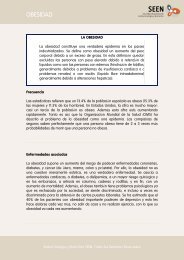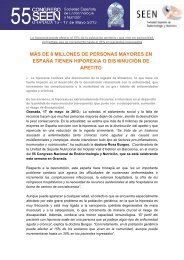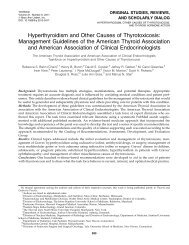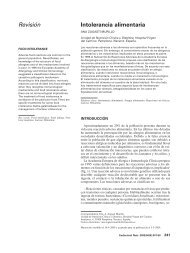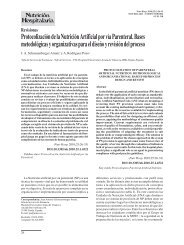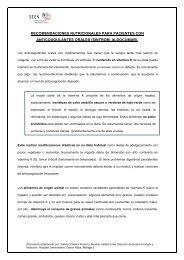Basic Concepts of Fluid and Electrolyte Therapy
Basic Concepts of Fluid and Electrolyte Therapy
Basic Concepts of Fluid and Electrolyte Therapy
You also want an ePaper? Increase the reach of your titles
YUMPU automatically turns print PDFs into web optimized ePapers that Google loves.
Treatment depends on severity <strong>and</strong> cause, but may involve vitamin D<br />
replacement in the form <strong>of</strong> 1- cholecalciferol <strong>and</strong>/or calcium supplements<br />
by the oral or intravenous routes.<br />
Magnesium (Mg 2+ )<br />
This is distributed mainly in bone (500-600mmol) <strong>and</strong> the ICF (500-<br />
850 mmol). Only 12-20 mmol are in the ECF at any given time, at a<br />
concentration <strong>of</strong> 0.7-1.2 mmol/l. It is an important component <strong>of</strong><br />
many enzyme systems <strong>and</strong> helps maintain cell membrane stability.<br />
The following facts are important to remember.<br />
Mg 2+ like Ca 2+ is bound to albumin <strong>and</strong> a low serum level should<br />
be interpreted in the light <strong>of</strong> the prevailing albumin concentration<br />
Mg 2+ concentration in gastrointestinal fluid varies according to<br />
the distance along the intestine. In upper small bowel fluid it is<br />
only present at 1 mmol/l, whereas in the distal small bowel it rises<br />
to higher concentrations. Significant hypomagnesaemia is therefore<br />
more likely to occur from chronic diarrhoea or from distal<br />
stomas or fistulae rather than from more proximal GI losses. GI<br />
losses are the most common cause <strong>of</strong> hypomagnesaemia in clinical<br />
practice.<br />
Hypomagnesaemia causes blood PTH levels to fall, with secondary<br />
hypocalcaemia. In all cases <strong>of</strong> hypocalcaemia therefore, the serum<br />
Mg 2+ should be measured. Replacement <strong>of</strong> Mg 2+ deficits restores<br />
PTH <strong>and</strong> hence Ca 2+ levels to normal.<br />
Overt symptoms <strong>of</strong> hypomagnesaemia, with neuromuscular irritability,<br />
convulsions, <strong>and</strong> arrhythmias are not usually apparent<br />
until the serum Mg 2+ falls below 0.4 mmol/l, although with milder<br />
degrees <strong>of</strong> hypomagnesaemia patients may experience improved<br />
well-being with adequate replacement, suggesting that even mild<br />
hypomagnesaemia may cause sub-clinical symptoms.<br />
110




